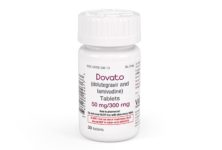People who are cured of hepatitis C after a course of direct-acting antiviral treatment do not have a higher risk of developing hepatocellular carcinoma (HCC) — and probably have a reduced risk — according to studies from Italy and Canada presented at American Association for the Study of Liver Diseases (AASLD) Liver Meeting this week in Boston.
However, the Italian researchers also found that those people who did develop liver cancer during or shortly after antiviral treatment were more likely to develop an aggressive form of cancer, perhaps because of changes in immune surveillance in the liver as a result of treatment.
Hepatitis C can be cured with a course of direct-acting antiviral (DAA) treatment, but eliminating the infection may not heal the liver sufficiently to prevent the development of liver cancer.
Furthermore, there is evidence that people with cirrhosis previously treated for HCC have a high rate of recurrence of liver cancer. Two studies, conducted in Italy and Spain, both found that around 30% of people previously treated for liver cancer experienced a recurrence within a median of 6 months after completing hepatitis C treatment. Both research groups considered the rate of recurrence in their patients to be unusual and warned doctors to be on the lookout for liver cancer recurrence.
To investigate whether these findings hold true in a larger population, researchers at hospitals in the Veneto region of northern Italy analyzed the incidence of hepatocellular carcinoma in a prospective study of 3075 consecutive patients with stage F3 or F4 fibrosis treated with direct-acting antivirals between January 2015 and June 2016; 72% had cirrhosis, in the vast majority of cases less advanced (Child-Pugh class A, 65%). People previously diagnosed with liver cancer were excluded from the analysis, as were people who had undergone liver transplantation prior to DAA treatment.
The population was almost two-thirds (63%) male, 62% had HCV genotype 1 infection, 12.7% had genotype 2, 17% had genotype 3, and 7.7% had genotype 4.
After an average follow-up period of approximately 10 months from the time of beginning hepatitis C treatment (300 days), 41 people had developed liver cancer, an incidence of 1.64 cases per 100 person-years (PY). Incidence ranged from 0.23 per 100 PY for people without cirrhosis to 1.93 per 100 PY for those with cirrhosis. Incidence was higher in those with Child-Pugh class B cirrhosis (2.92) than in those with Child Pugh class A (1.64), but this difference was not statistically significant.
These incidence rates compare to observed incidence rates of 2.8 per 100 person years among untreated hepatitis C patients in the same region of Italy previously reported by the same research network.
Incidence was higher among people with HCV genotype 3 or 4 infection, but genotype was not significantly associated with the development of HCC. Multivariate analysis showed that the only factors associated with development of HCC were baseline aspartate transaminase (AST) and platelet counts.
The baseline APRI score — indicating the degree of liver scarring — was the strongest predictor of development of liver cancer, with each 1-point increase in APRI score being associated with a 10% increase in the risk of liver cancer.
Although the study found a reduced risk of liver cancer among those who were cured of HCV infection, it also found an unusually high proportion of the cases that did occur were more aggressive, manifesting as multiple HCC nodules or infiltrative HCC. 16 of 41 cases took this form (39%), and these aggressive cases of HCC were more frequently seen in the first 6 months after the initiation of DAA treatment. Single-nodule cases of HCC were more likely to occur at least 6 months after DAA initiation.
Speaking at an AASLD press conference, Alfredo Alberti, professor of gastroenterology at the University of Padova,said that changes in the immunological and tumor-suppressive environment in the liver as a result of the rapid elimination of viral replication might permit more rapid growth of tumors already present in the liver. Participants in the study were screened for the presence of tumors by ultrasound 3 months before initiating treatment, so the presence of tumors at the time of treatment initiation cannot be ruled out definitively.
A larger study, of the entire population of people treated for hepatitis C in British Columbia, Canada, between 1990 and 2013 found that the risk of liver cancer was reduced by 80% in people cured of hepatitis C compared to those who were not cured. This study did not look at the relationship between exposure to DAAs and liver cancer risk.
The study identified 8147 people treated with interferon-based regimens, 57% of whom were cured. Treated individuals were followed for a median of 5.6 years.
Liver cancer incidence was highest among people with cirrhosis who did not achieve a sustained virological response (2.1 cases per 100 PY of follow up). In comparison, liver cancer incidence was .64 per 100 PY for those with cirrhosis who achieved SVR, .72 per 100 PY for those without cirrhosis who did not achieve SVR12, and .11 per 100 PY for those without cirrhosis who achieved SVR12.
In a multivariable analysis liver cancer was associated with cirrhosis, age over 50 years, HCV genotype 3 infection versus genotype 1, alcohol consumption, and being male among those who were not cured of hepatitis C. Among those who were cured, only cirrhosis, age over 50, and being male were associated with an increased risk of liver cancer.
The British Columbia researchers concluded that although curing hepatitis C infection greatly reduces the risk of developing liver cancer, it does not eliminate the risk entirely. Older people and those with cirrhosis are at higher risk than others, underlining the importance of early diagnosis and treatment.
By Keith Alcorn
Sources
A Romano, F Capra, S Piovesan, A Alberti, et al. Incidence and pattern of “de novo” hepatocellular carcinoma in HCV patients treated with oral DAAs. 67th Meeting of the American Association for the Study of Liver Diseases: Liver Meeting 2016. Boston, November 11-15, 2016. Abstract 19.
NZ Janjua, MY Chong, ME Kuo, et al. The impact of sustained virological response to HCV infection on long-term risk of hepatocellular carcinoma: the BC Hepatitis Testers Cohort. 67th Meeting of the American Association for the Study of Liver Diseases: Liver Meeting 2016. Boston, November 11-15, 2016. Abstract 175.
AASLD. Is There an Increased Risk of Cancer After Taking Direct-Acting Antiviral Medication? Press release. November 11, 2016.


 ПОИСК ПО САЙТУ
ПОИСК ПО САЙТУ  поиск по ресурсному центру
поиск по ресурсному центру 



